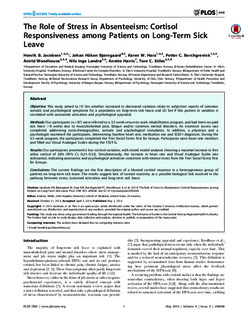| dc.contributor.author | Jacobsen, Henrik Børsting | |
| dc.contributor.author | Bjørngaard, Johan Håkon | |
| dc.contributor.author | Hara, Karen Walseth | |
| dc.contributor.author | Borchgrevink, Petter Chr. | |
| dc.contributor.author | Woodhouse, Astrid | |
| dc.contributor.author | Landrø, Nils Inge | |
| dc.contributor.author | Harris, Anette | |
| dc.contributor.author | Stiles, Tore C | |
| dc.date.accessioned | 2015-01-06T07:20:15Z | |
| dc.date.accessioned | 2016-04-27T13:57:46Z | |
| dc.date.available | 2015-01-06T07:20:15Z | |
| dc.date.available | 2016-04-27T13:57:46Z | |
| dc.date.issued | 2014 | |
| dc.identifier.citation | PLoS ONE 2014, 9(5) | nb_NO |
| dc.identifier.issn | 1932-6203 | |
| dc.identifier.uri | http://hdl.handle.net/11250/2387657 | |
| dc.description.abstract | Objective: This study aimed to (1) See whether increased or decreased variation relate to subjective reports of common
somatic and psychological symptoms for a population on long-term sick leave; and (2) See if this pattern in variation is
correlated with autonomic activation and psychological appraisal.
Methods: Our participants (n = 87) were referred to a 3.5-week return-to-work rehabilitation program, and had been on paid
sick leave .8 weeks due to musculoskeletal pain, fatigue and/or common mental disorders. An extensive survey was
completed, addressing socio-demographics, somatic and psychological complaints. In addition, a physician and a
psychologist examined the participants, determining baseline heart rate, medication use and SCID-I diagnoses. During the
3.5-week program, the participants completed the Trier Social Stress Test for Groups. Participants wore heart rate monitors
and filled out Visual Analogue Scales during the TSST-G.
Results: Our participants presented a low cortisol variation, with mixed model analyses showing a maximal increase in free
saliva cortisol of 26% (95% CI, 0.21–0.32). Simultaneously, the increase in heart rate and Visual Analogue Scales was
substantial, indicating autonomic and psychological activation consistent with intense stress from the Trier Social Stress Test
for Groups.
Conclusions: The current findings are the first description of a blunted cortisol response in a heterogeneous group of
patients on long-term sick leave. The results suggest lack of cortisol reactivity as a possible biological link involved in the
pathway between stress, sustained activation and long-term sick leave. | nb_NO |
| dc.language.iso | eng | nb_NO |
| dc.publisher | Public Library of Science | nb_NO |
| dc.rights | Navngivelse 3.0 Norge | * |
| dc.rights.uri | http://creativecommons.org/licenses/by/3.0/no/ | * |
| dc.title | The role of stress in absenteeism: Cortisol responsiveness among patients on long-term sick leave | nb_NO |
| dc.type | Journal article | nb_NO |
| dc.type | Peer reviewed | nb_NO |
| dc.date.updated | 2015-01-06T07:20:15Z | |
| dc.source.volume | 9 | nb_NO |
| dc.source.journal | PLoS ONE | nb_NO |
| dc.source.issue | 5 | nb_NO |
| dc.identifier.doi | 10.1371/journal.pone.0096048 | |
| dc.identifier.cristin | 1140155 | |
| dc.description.localcode | © 2014 Jacobsen et al. This is an open-access article distributed under the terms of the Creative Commons Attribution License, which permits unrestricted use, distribution, and reproduction in any medium, provided the original author and source are credited. | nb_NO |

